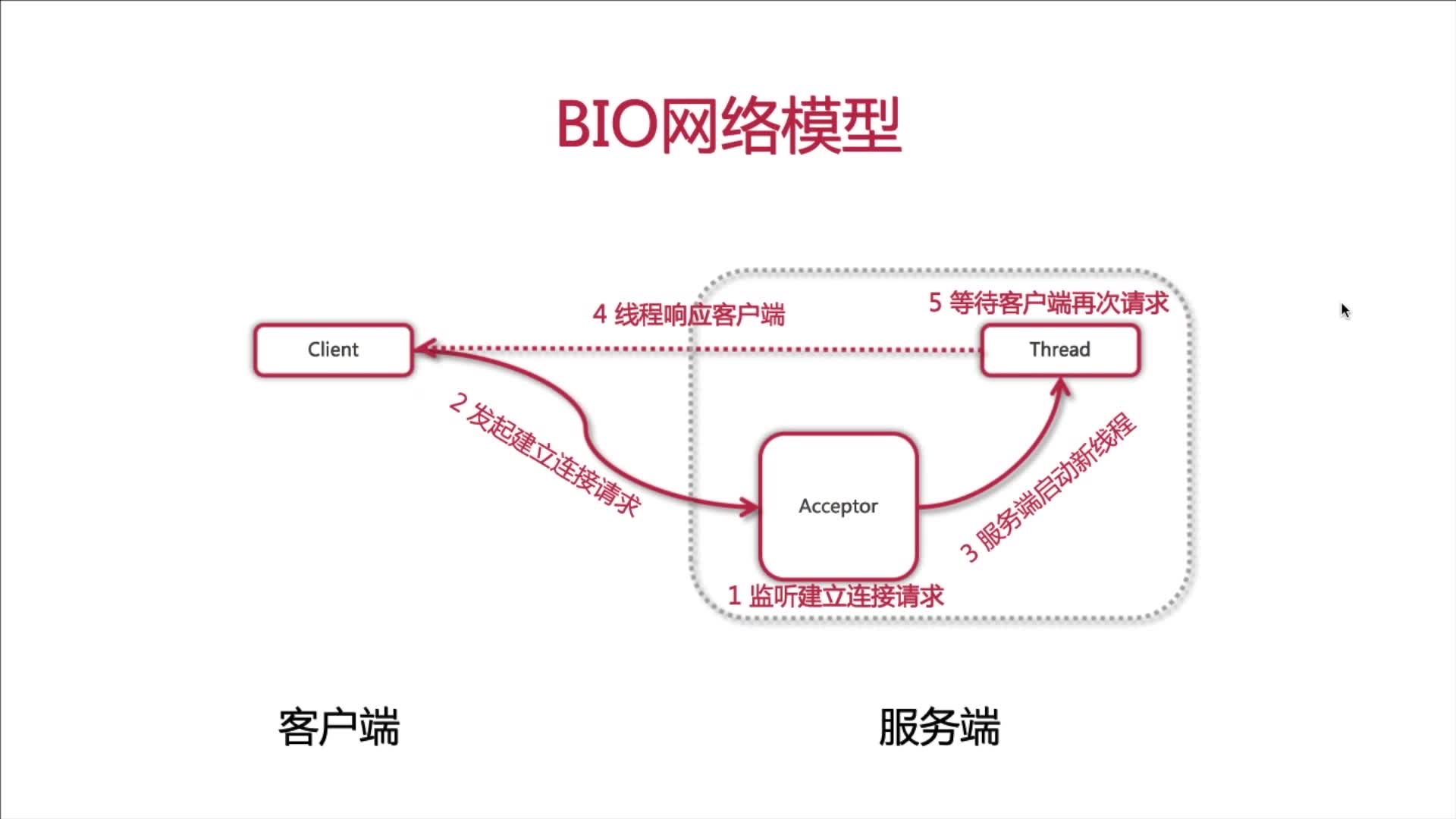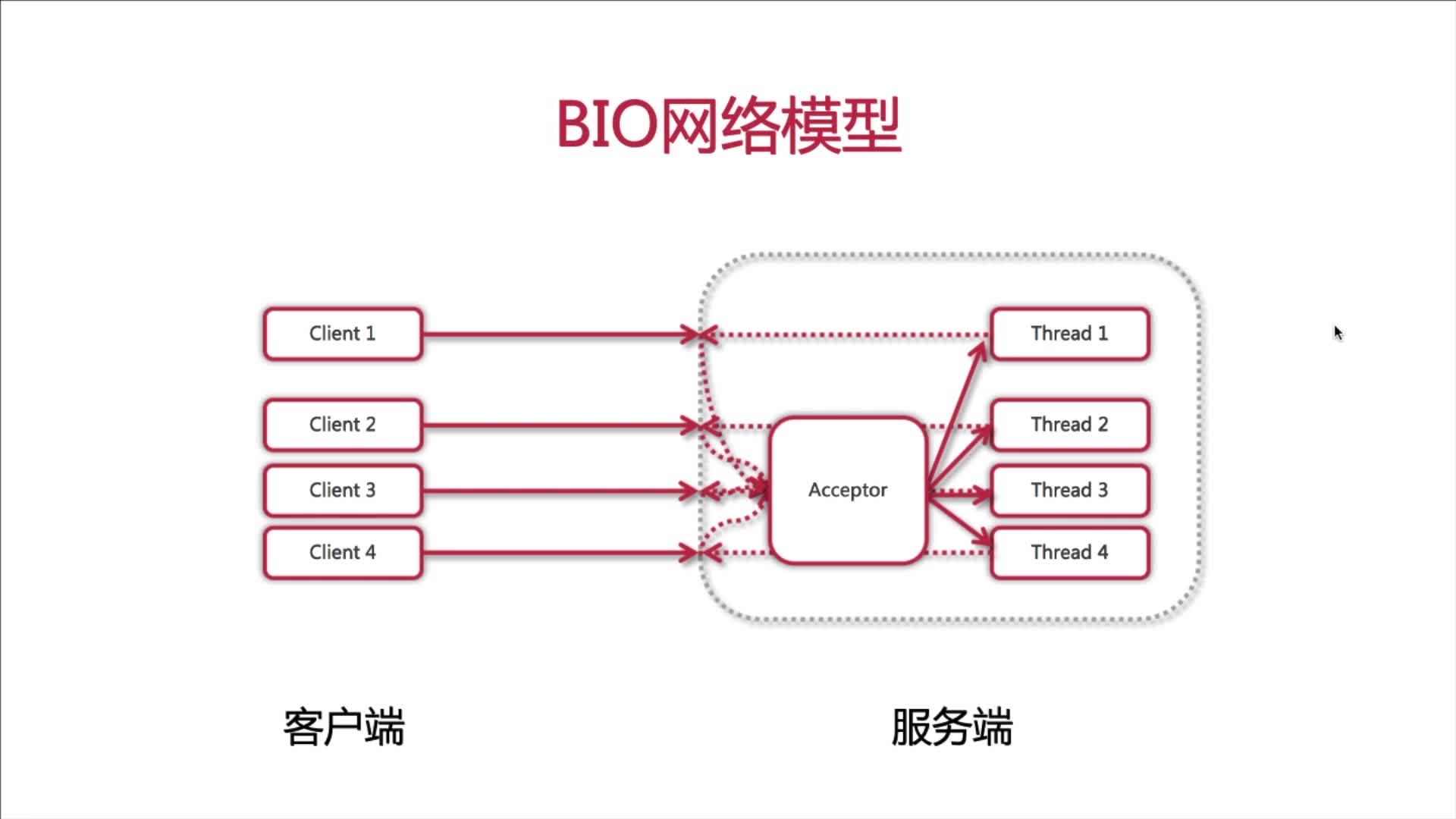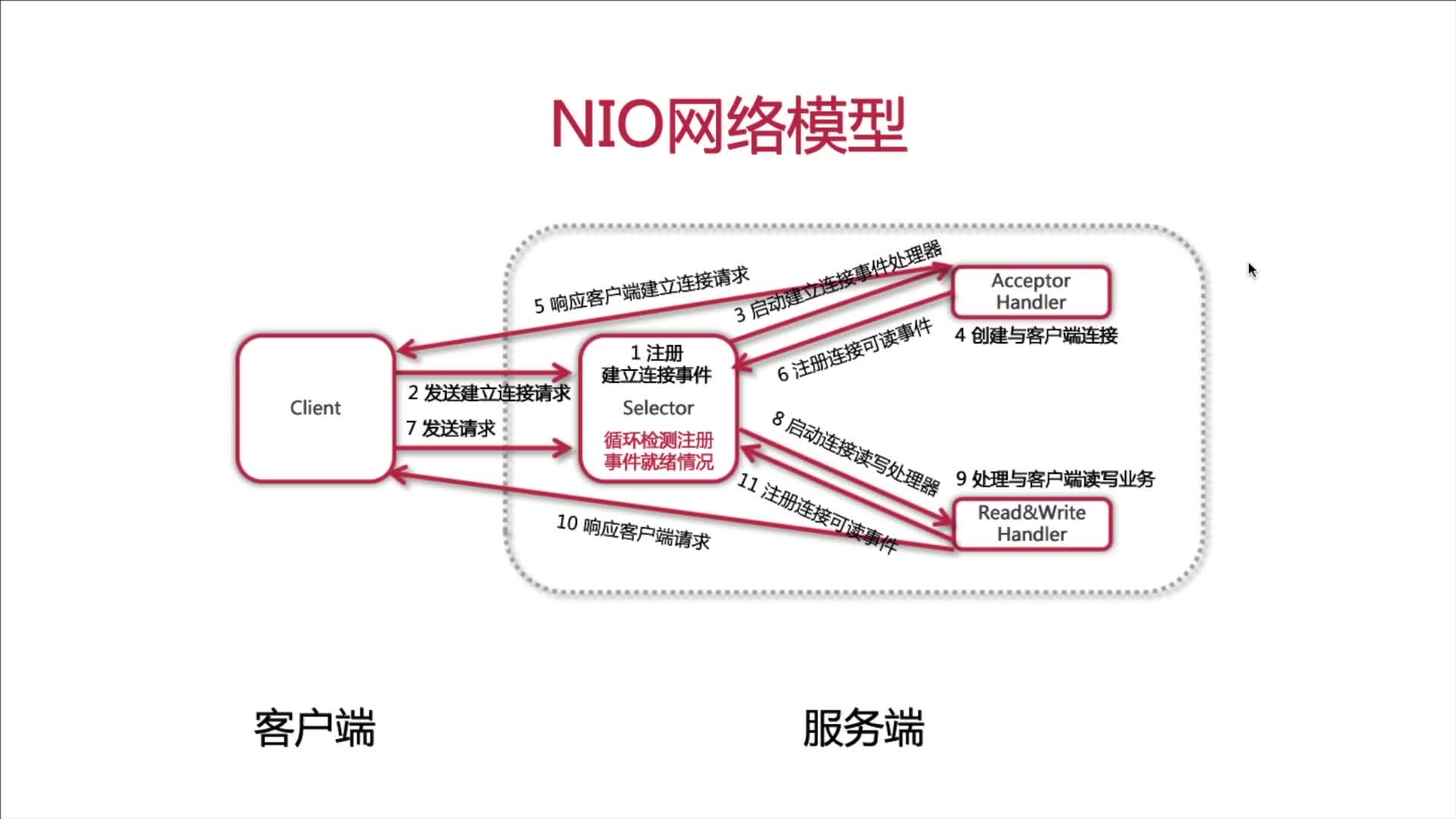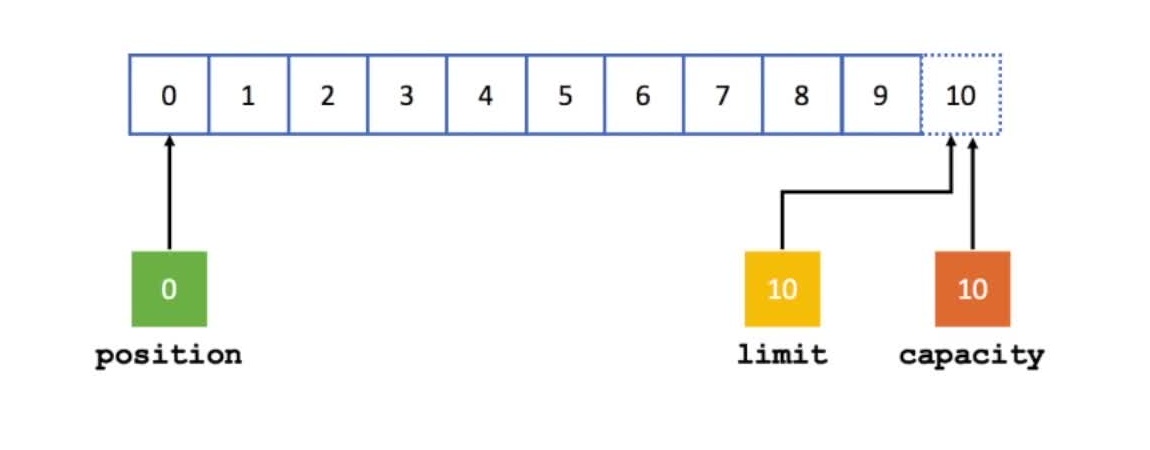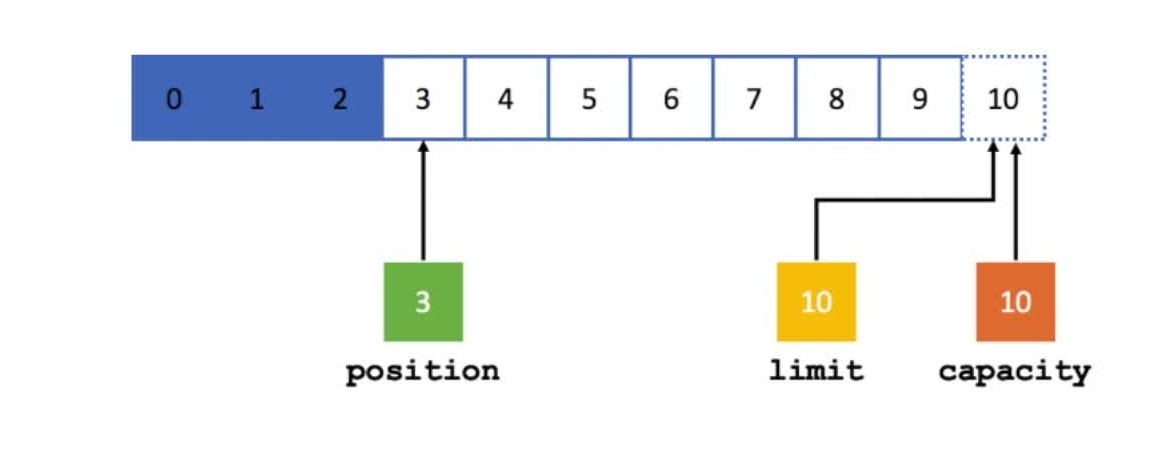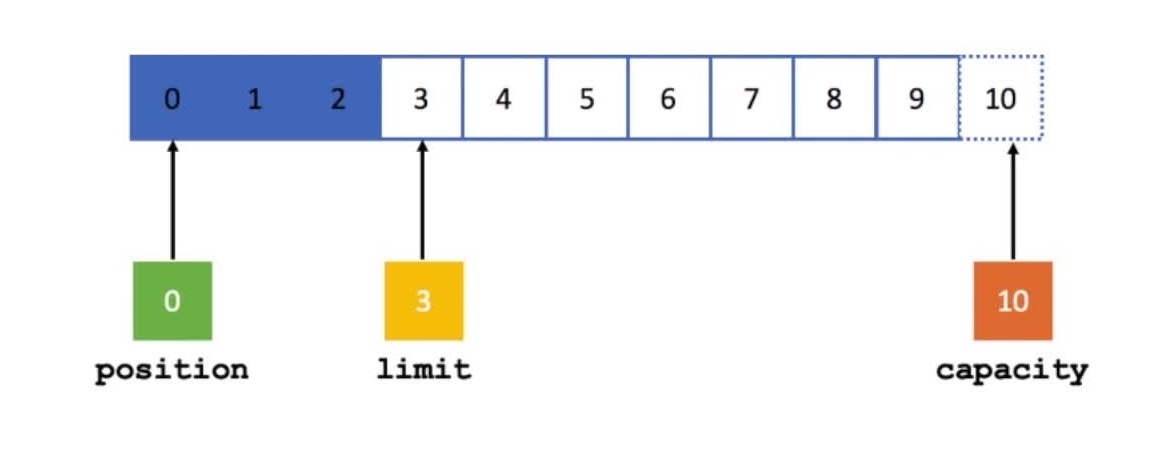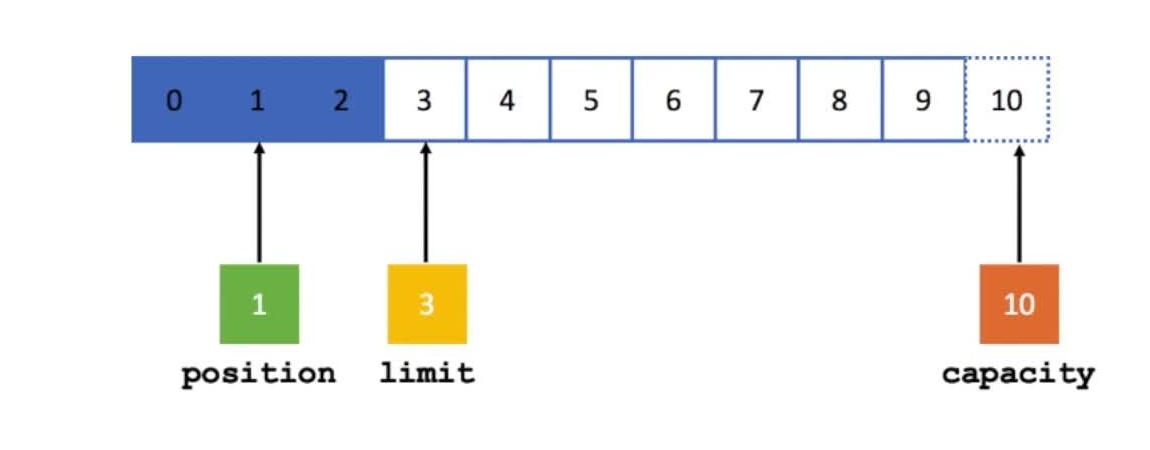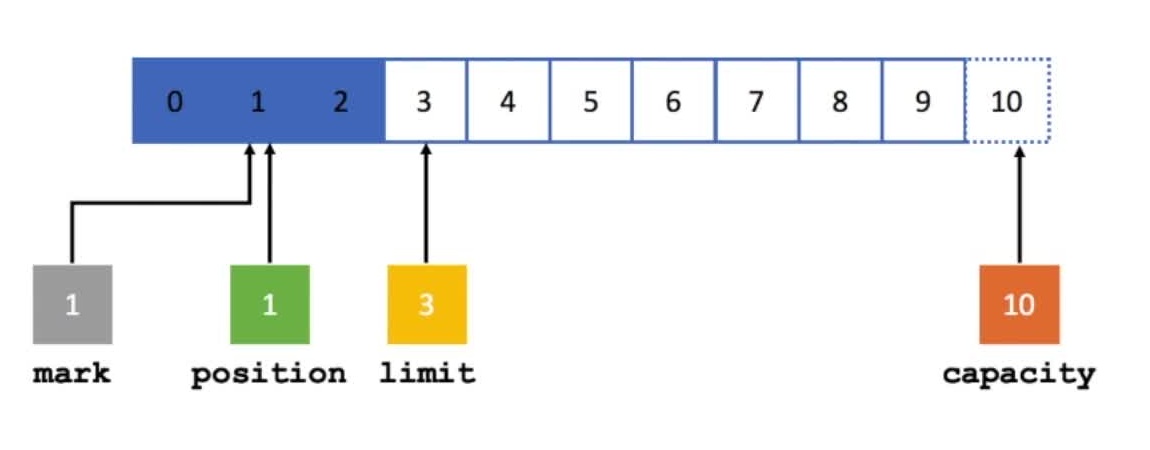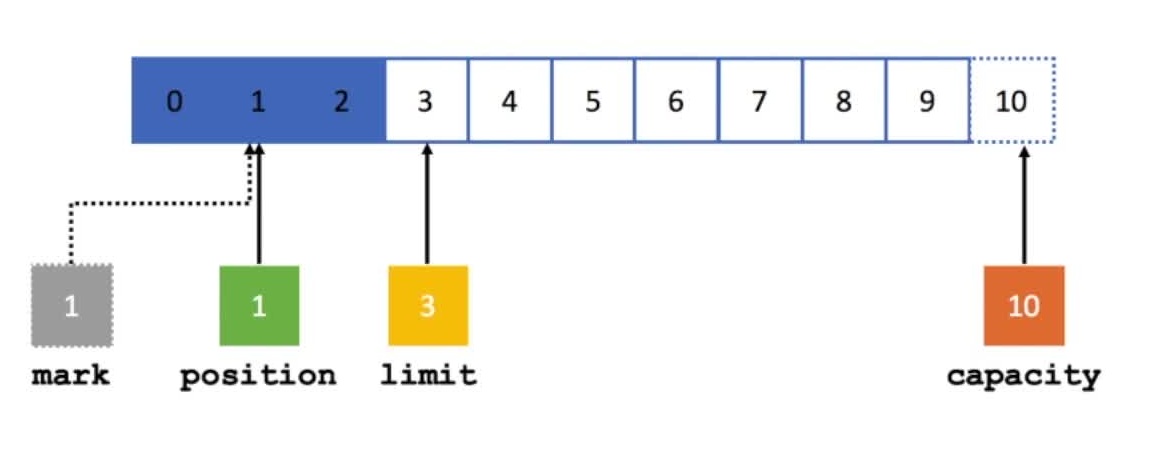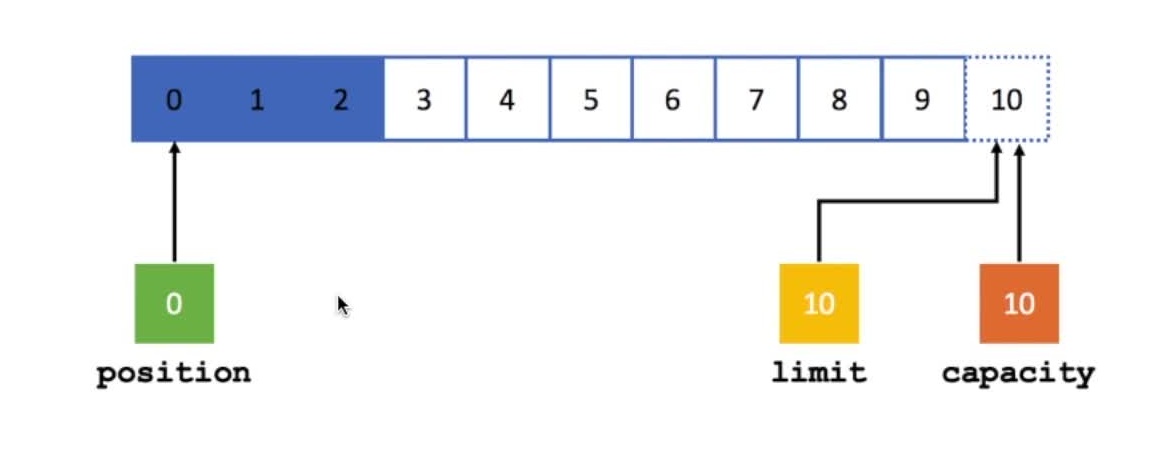前置知识
- Java 基础知识
- BIO 网络编程知识
- 多线程编程知识
- 阻塞式 I/O 模型
- 如果客户端没有发起请求,服务的会一直存在并等待连接
- 弹性伸缩能力差
- 每一个对服务端的连接就需要开启一个线程
- 连接数很可能超过服务器所能负载的最大线程数
- 多线程耗资源
- 创建,销毁,维护大量线程以及线程切换都非常消耗系统资源
- 非阻塞 IO 模型
- 服务器端提供一个单线程的 selector 来统一管理所有客户端接入的连接
- 并负责监听每个连接所关心的事件
- 弹性伸缩能力加强
- 服务器端一个线程处理所有客户端的连接请求
- 客户端的个数与服务器端的线程数呈 M 比 1 的关系
- 单线程节省资源
- 避免了线程的频繁创建和销毁
- 同时也避免了多个线程之间上下文的切换,提高了执行效率
NIO 核心
Channel:通道Buffer:缓冲区Selector:选择器或多路复用器
特点:
- 双向性
- 非阻塞性
- 操作唯一性
实现:
- 文件类:
FileChannel - UDP 类:
DatagramChannel - TCP 类:
ServerSocketChannel/SocketChannel
/*
代码片段1:服务器端通过服务端socket创建channel
*/
ServerSocketChannel serverSocketChannel = ServerSocketChannel.open();/*
代码片段2:服务器端绑定端口
*/
serverSocketChannel.bind(new InetSocketAddress(8000));/*
代码片段3:服务器端监听客户端连接,建立socketChannel连接
*/
SocketChannel socketChannel = serverSocketChannel.accept();/*
代码片段4:客户端连接远程主机及端口
*/
SocketChannel socketChannel = SocketChannel.open(
new InetSocketAddress("127.0.0.1", 8000));作用:读写 Channel 中数据
本质:一块内存区域
属性:
Capacity:容量Position:位置Limit:上限Mark:标记
用法:
/*
初始化长度为10的byte类型buffer
*/
ByteBuffer.allocate(10);/*
向byteBuffer中写入三个字节
*/
ByteBuffer.put("abc".getBytes(Charset.forName("UTF-8")));/*
将byteBuffer从写模式写换到读模式
*/
ByteBuffer.flip();/*
从byteBuffer中读取一个字节
*/
ByteBuffer.get();/*
调用mark方法记录下当前position的位置
*/
ByteBuffer.mark();/*
先调用get方法读取下一个字节
再调用reset方法将position重置到mark位置
*/
ByteBuffer.get();
ByteBuffer.reset();/*
调用clear方法,将所有属性重置
*/
ByteBuffer.clear();作用:I/O 事件就绪选择
地位:NIO 网络编程的基础之一
/*
代码片段1,创建Selector
*/
Selector selector = Selector.open();/*
代码片段2,将channel注册到selector上,监听读就绪事件
*/
serverSocketChannel.register(selector, SelectionKey.OP_READ);/*
代码片段3,阻塞等待channel有就绪事件发生
*/
int selectNum = selector.select();/*
代码片段4,获取发生就绪事件的channel集合
*/
Set<SelectionKey> selectionKeys = selector.selectedKeys();SelectionKey 提供四种就绪状态常量:
- 连接就绪:
connect - 接受就绪:
accept - 读就绪:
read - 写就绪:
write
- 第一步:创建
Selector - 第二步:创建
ServerSocketChannel,并绑定监听端口 - 第三步:将
Channel设置为非阻塞模式 - 第四步:将
Channel注册到Selector上,监听连接事件 - 第五步:循环调用
Selector的select方法,检测就绪情况 - 第六步:调用
selectedKeys方法获取就绪channel集合 - 第七步:判断就绪事件种类,调用业务处理方法
- 第八步:根据业务需要决定是否再次注册监听事件,重复执行第三步操作
/*
1. 创建Selector
*/
Selector selector = Selector.open();
/*
2. 通过ServerSocketChannel查u你更加爱你channel
*/
ServerSocketChannel serverSocketChannel = ServerSocketChannel.open();
/*
3. 为channel绑定监听端口
*/
serverSocketChannel.bind(new InetSocketAddress(8000));
/*
4. 设置Channel为非阻塞模式
*/
serverSocketChannel.configureBlocking(false);
/*
5. 将Channel注册到Selector上,监听连接事件
*/
serverSocketChannel.register(selector, SelectionKey.OP_ACCEPT);
System.out.println("服务器端启动成功!");/*
6. 循环等待新接入的连接
*/
for (; ; ) {
/*
获取可用channel数量
*/
int readChannels = selector.select();
if (readChannels == 0) {
continue;
}
/*
获取可用channel地集合
*/
Set<SelectionKey> selectionKeySet = selector.selectedKeys();
Iterator iterator = selectionKeySet.iterator();
while (iterator.hasNext()) {
/*
selectionKey实例
*/
SelectionKey selectionKey = (SelectionKey) iterator.next();
/*
移除Set中当前selectionKey实例
*/
iterator.remove();
/*
7. 根据对应状态,调用对应方法处理业务逻辑
*/
if (selectionKey.isAcceptable()) {
/*
如果是接入事件
*/
acceptHandler(serverSocketChannel, selector);
}
if (selectionKey.isReadable()) {
/*
如果是可读事件
*/
readHandler(selectionKey, selector);
}
}
}private void acceptHandler(ServerSocketChannel serverSocketChannel,
Selector selector)
throws IOException {
/*
如果要是接入事件,创建socketChannel
*/
SocketChannel socketChannel = serverSocketChannel.accept();
/*
将socketChannel设置为非阻塞工作模式
*/
socketChannel.configureBlocking(false);
/*
将channel注册到selector上,监听可读事件
*/
socketChannel.register(selector, SelectionKey.OP_READ);
/*
回复客户端提示信息
*/
socketChannel.write(StandardCharsets.UTF_8
.encode("你与聊天室里其他人都不是朋友关系,请注意隐私安全"));
}private void readHandler(SelectionKey selectionKey, Selector selector)
throws IOException {
/*
要从SelectionKey中获取到已经就绪的channel
*/
SocketChannel socketChannel = (SocketChannel) selectionKey.channel();
/*
创建buffer
*/
ByteBuffer byteBuffer = ByteBuffer.allocate(1024);
/*
循环读取客户端请求信息
*/
StringBuilder request = new StringBuilder();
while (socketChannel.read(byteBuffer) > 0) {
/*
切换buffer为读模式
*/
byteBuffer.flip();
/*
读取buffer中的内容
*/
request.append(StandardCharsets.UTF_8.decode(byteBuffer));
}
/*
将channel再次注册到selector上,监听他的可读事件
*/
socketChannel.register(selector, SelectionKey.OP_READ);
/*
将客户端发送的请求信息,广播给其他客户端
*/
if (request.length() > 0) {
boardCast(selector, socketChannel, request.toString());
}
}private void boardCast(Selector selector, SocketChannel sourceChannel,
String request) {
/*
获取到所有已接入的客户端channel
*/
Set<SelectionKey> selectionKeySet = selector.keys();
/*
循环向所有channel广播信息
*/
selectionKeySet.forEach(selectionKey -> {
Channel targetChannel = selectionKey.channel();
/*
剔除发消息的客户端
*/
if (targetChannel instanceof SocketChannel && targetChannel != sourceChannel) {
try {
/*
将消息发送到targetChannel客户端
*/
((SocketChannel) targetChannel).write(StandardCharsets.UTF_8.encode(request));
} catch (IOException e) {
e.printStackTrace();
}
}
});
}/*
连接服务器端
*/
SocketChannel socketChannel = SocketChannel.open(
new InetSocketAddress("127.0.0.1", 8000));
System.out.println("客户端启动成功!");
/*
接收服务器端响应
新开线程,专门负责来接收服务器端的响应数据
selector socketChannel 注册
*/
Selector selector = Selector.open();
socketChannel.configureBlocking(false);
socketChannel.register(selector, SelectionKey.OP_READ);
new Thread(new NioClientHandler(selector)).start();
/*
向服务器端发送数据
*/
Scanner scanner = new Scanner(System.in);
while (scanner.hasNextLine()) {
String request = scanner.nextLine();
if (request != null && request.length() > 0) {
socketChannel.write(StandardCharsets.UTF_8.encode(nickname + " : " + request));
}
}for (; ; ) {
int readChannels = selector.select();
if (readChannels == 0) {
continue;
}
Set<SelectionKey> selectionKeySet = selector.selectedKeys();
Iterator iterator = selectionKeySet.iterator();
while (iterator.hasNext()) {
SelectionKey selectionKey = (SelectionKey) iterator.next();
iterator.remove();
if (selectionKey.isReadable()) {
readHandler(selectionKey, selector);
}
}
}private void readHandler(SelectionKey selectionKey, Selector selector)
throws IOException {
SocketChannel socketChannel = (SocketChannel) selectionKey.channel();
ByteBuffer byteBuffer = ByteBuffer.allocate(1024);
StringBuilder response = new StringBuilder();
while (socketChannel.read(byteBuffer) > 0) {
byteBuffer.flip();
response.append(StandardCharsets.UTF_8.decode(byteBuffer));
}
socketChannel.register(selector, SelectionKey.OP_READ);
if (response.length() > 0) {
System.out.println(response);
}
}- 麻烦
- NIO 类库和 API 繁杂
- 心累
- 可靠性能力补齐,工作量和难度都非常大
- 有坑
- Selector 空轮询,导致 CPU 占用率 100%
